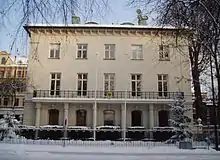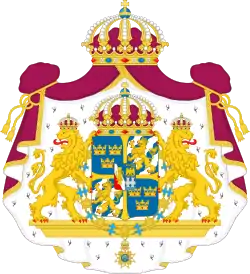Poland–Sweden relations
Poland–Sweden relations is historical and bilateral between Poland and Sweden. Both countries are separated by the Baltic Sea and have had a very long historical contact, and it also survived several conflicts between the two countries as well.[1] At the beginning of 20th century, Poland and Sweden did enjoy a close relationship only to be interrupted by the Soviet and German invasion of Poland, which started World War II. After the war, both re-established relations and Sweden has become the largest economic contributor for Poland among the Nordic countries. Both Poland and Sweden are EU members. There are over 90.000 Poles in Sweden and residents from both countries visit the other frequently.
 | |
Poland |
Sweden |
|---|---|
| Diplomatic mission | |
| Embassy of Poland, Stockholm | Embassy of Sweden, Warsaw |
History
.jpg.webp)
The Jagiellonian dynasty which ruled Poland from 1386 to 1596 was thought to have some Swedish ancestry and played a significant role in developing Poland into a major European power in the medieval days of Europe. One of Poland's most significant rulers, Sigismund III Vasa, was also partly Swedish through his father King John III of Sweden. Sigismund's mother was Polish Princess Catherine Jagiellon.[2] Under the rule of Sigismund III both countries formed the Polish–Swedish union, which encompassed most of the Baltic region, and from 1561 to 1722, the two countries shared a common border in Livonia.
At the same time, both Poland, as part of the Polish–Lithuanian Commonwealth, and Imperial Sweden had ambitious plans to expand territorial gains and consolidate power, which led to many major conflicts between the two nations, challenging the power of each. At peak, the Swedes invaded Poland once, known as the Swedish Deluge,[3] which later had razed much of Poland after serious destructions by the Swedish invaders. The weakening of Poland had been contributed by the brutal Swedish invasion.
In the 18th century, the partitions of Poland awoke Swedish fear of suffering a similar fate at the hands of Russia, but after the Russo–Swedish war ended in 1790, successful Swedish diplomatic missions prevented such an outcome, however, Sweden, similarly to Poland, lost large territories in the east to Russia in 1721 and 1809.
Sweden was the main destination for many immigrants from partitioned Poland.
Two World Wars
During both World War I and World War II, the Polish community in Sweden were very supportive of independent Poland without being controlled by both the Germans and the Russians. Especially during World War II, several members of Home Army used Sweden, a neutral country, to facilitate and fund the Polish resistance. Several Swedish citizens had also helped and supported Polish resistance and gave them shelters, also protect Poles from being hunted by the Nazis.
Resident diplomatic missions
 Embassy of Poland in Stockholm
Embassy of Poland in Stockholm Embassy of Sweden in Warsaw
Embassy of Sweden in Warsaw
References
- Relations between Poland and Sweden over the centuries
- "Sigismund III Vasa". Archived from the original on 1 January 2018. Retrieved 30 October 2016.
- "The Swedish Deluge".
- Embassy of Poland in Stockholm
- "Embassy of Sweden in Warsaw". Archived from the original on 2018-02-08. Retrieved 2017-12-19.

